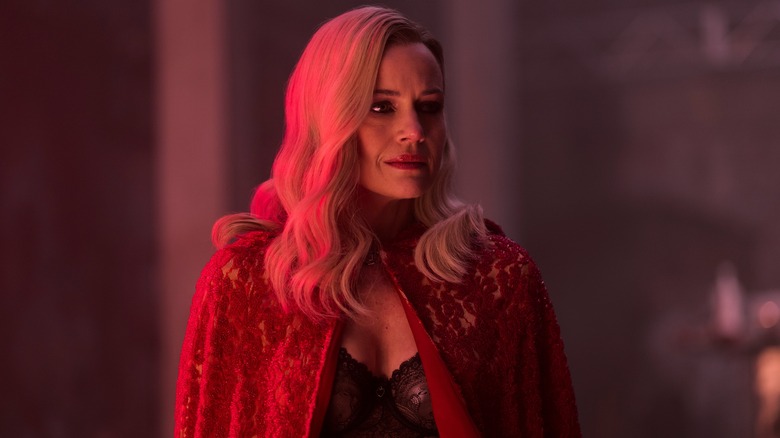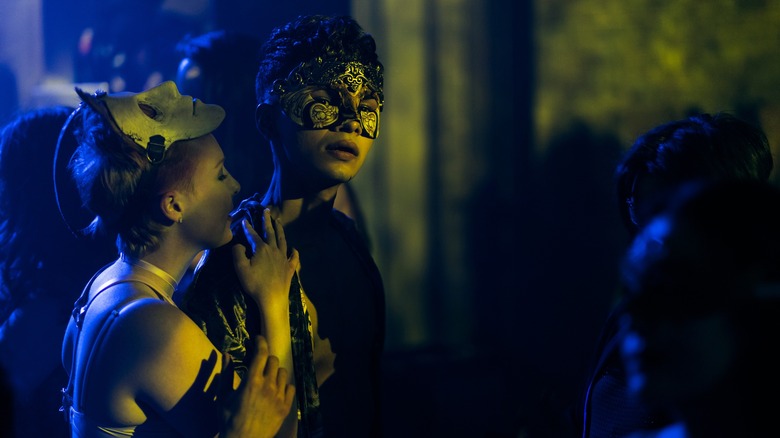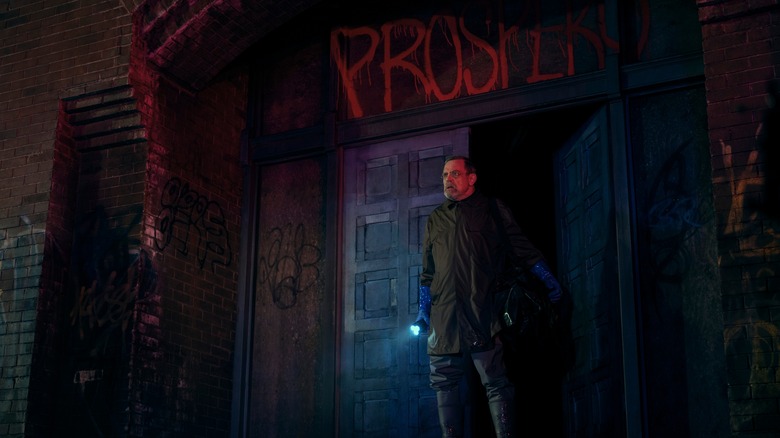The Fall Of The House Of Usher Pulled Most Of Its Look From An Entirely Different Poe Story
This article contains spoilers for "The Fall of the House of Usher."
It may have been published in 1842, but Edgar Allan Poe's "The Masque of the Red Death" feels uncomfortably topical in the 2020s. The story tells of a fast-spreading disease that devastates a country, and the selfish Prince Prospero who abandons his peasants to their agonizing deaths, corralling a thousand wealthy nobles inside one of his fortresses and throwing a wild masked ball to keep them entertained.
The story was adapted into the second episode of Mike Flanagan's Netflix horror series "The Fall of the House of Usher," which sees Prospero "Perry" Usher organizing an elites-only rave/drug-fueled orgy in a condemned Fortunato Pharmaceuticals factory. Production designer Laurin Kelsey told Bloody Disgusting that of all the many Poe stories woven into the series, "The Masque of the Red Death" was "the one that was probably the most drawn upon from our side, from a production design side and art direction side."
It certainly helps that Poe did everything but draw a blueprint of the "castellated abbey" in which the ball is held, going into exacting detail about the architecture and the color theme of each of the seven apartments contained within. The last of these rooms, where the arrogant Prince Prospero meets his death, is decorated all in black, with an ebony clock counting down the time with "dull, heavy, monotonous clang." Upon each hour, it releases "peculiar" chimes that briefly silence the revelers — an unwelcome reminder, to those who think that wealth and privilege will protect them, that the Red Death is coming for them all.
'It was in the blue room where stood the prince, with a group of pale courtiers by his side'
Yes, "The Masque of the Red Death" ended up being a particularly timely adaptation; behind-the-scenes photos show the crew and creative team wearing masks of their own, due to the COVID-19 production policies that were still in place when "The Fall of the House of Usher" was filming. And the story's influence can be seen not only in the second episode, but across the entire series. Just as each of the seven rooms in Prospero's castle has a distinctive color palette — blue, purple, green, orange, white, violet, and finally a combination of black and blood-red — each of the Ushers was assigned a specific color.
"One of the really cool things that Mike [Flanagan] brought in from the beginning was color," Kelsey explained in an interview for The Credits. "Camille is silver, Leo is yellow, Victorine is orange, Perry is red, Frederick's blue." Roderick and Madeline are linked with gold and purple, respectively, and Tamerlane is surrounded by the color green.
Linking the characters to particular colors was easily achievable through collaboration with costume designer Terry Anderson and cinematographer Michael Fimognari. Faithfully transforming the layout of Prince Prospero's complex castle into a run-down old warehouse required a deeper dive — along with some creative interpretation.
'And one by one dropped the revelers in the blood-bedewed halls of their revel'
Though there are seven rooms described in "The Masque of the Red Death," we only really see two in "The Fall of the House of Usher" — the warehouse that serves as the main dance floor, and a bedroom where Prospero has an encounter with the mysterious Verna. The rave set was built from scratch, and despite not being able to show the entire scope of it, Kelsey told Bloody Disgusting that she tried to replicate Poe's descriptions in her own design:
"When we laid out the building, Mike and I talked about having a long space, so it felt like the hallway, which is one of the images that's pretty popular for 'The Masque of the Red Death.' Then, at the end of the building, we made sure that we had some big arched windows that were reminiscent of that feeling of stained glass. Down the side hallways, even though we don't see very much of the bedrooms and everything, that's all drawn upon the original story as well. Everything's balanced, and all the intricate details of how many doors and where they're placed is all kind of based on my interpretation of the original story."
Thanks to the wonders of modern technology, the lighting in the rave also shifts colors, allowing the main dance room to serve as both the blue room (symbolic of youth, where Prince Prospero is situated when the spectre of the Red Death first arrives) and the black chamber with its blood-red stained glass windows (where the Red Death catches up to Prospero and kills him). At the start of the rave the lights are blue, but just before the sprinkler system begins to drench the revelers in a horrifying and lethal shower of acid, everything turns red.
"The Fall of the House of Usher" is available now on Netflix.


